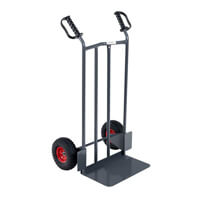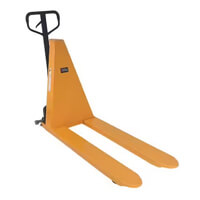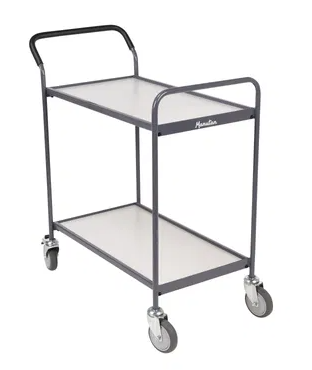First invented in the 1700s for making heavy lifting easier, hand trucks are used for the same reason today. Speeding up the transportation of items in a variety of shapes of sizes, they’ve become an important tool in warehouses, factories and storerooms, as they can simplify the process of moving almost any item.
Available with or without the option to fold away for easy storage, they’re built in an L-shape, with a flat sheet along the bottom that can easily slot underneath whatever you want to move. It can then be tilted backwards on a wheel at the rear of the truck, offering easy movement to wherever the object needs to go.
For your own safety, it’s worth learning the most effective way to use a hand truck. In this blog, we look at other considerations around using a hand truck, such as ensuring that the tyres are in good condition and not exceeding the advised weight limit.
Why is a hand truck called a dolly?
There are many different names for a hand truck, and while some are shaped for carrying specific items, they’re all a variation on the same thing. Hand trucks are also often referred to as sack trucks, sack barrows, bag barrows, trolley trucks,
stack trucks, two-wheelers, box carts, trundlers or simply trolley. They are sometimes also known as a dolly, which is a word often used in relation to any piece of equipment that transports items.
The origin of a hand truck being referred to as a dolly is unclear, but there are theories as to why it became a popular nickname. These include it being used as slang to mean a smaller version of a trolley, and how it resembles a doll in railroad hand carts due to having arms and legs.

How to inflate hand truck tyres
The tyres on a typical hand truck are strong enough to support the weight of most items. After excessive use, your hand truck’s tyres may need to be reinflated, but it’s easy to do this yourself.
Tips for inflating the tyres on your hand truck:
- Start by cleaning the tyre, removing any dirt and making sure that nothing is obstructing the tyre valve.
- Connect your pump to the valve of the tyre. A foot pump, bike pump or electric pump will work.
- You should now attach a few cable ties around the tyre, only tightening them enough to grip the tyre. By using cable ties, you will be able to judge how much you’re pumping the tyre up, not going so far that it damages the tyre but doing enough to improve your hand truck’s movement and performance.
- Once the ties are in place, you can begin to pump air into the tyre. When you can see the seal, the tyre should be sufficiently pumped up. You can now use pliers to cut the cable ties off the tyre, making sure you avoid cutting into the tyre itself.
- Remove the pump from the tyre valve, replacing with the cap as soon as possible to prevent air from escaping.
How much weight can a hand truck hold?
It’s important to take note of the load capacity of the hand truck you’re using. By ignoring this and choosing to put whatever you want on your hand truck with no regard for the weight, you could cause damage to the item being transported, the person using the hand truck, and the hand truck itself.
If you’ve decided to take the risk of using your hand truck to transport an item that exceeds the weight limit, you could end up in a difficult situation if it breaks partway through using it. This could happen if the metal or wheels give way, resulting in irreparable damage to the hand truck and a strong chance of damage to the item it was carrying.
Each hand truck is different, and with that comes a different restriction over how much weight it can carry. On average, a typical hand truck would be able to carry around 300kg standing up and 200kg during transportation. It’s important to find out what the load capacity is and to understand the difference between the static and mobile limits.





Leave a Reply
You must be logged in to post a comment.